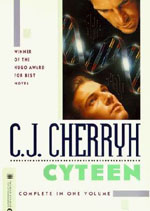 Cyteen is like a freight train. Half way down the first page the freight train hits you, and then you spend the rest of the book speeding along at eighty miles per hour, trying to figure out which is more exciting and terrifying: The pain from the impact, the rush of the air, or the beautiful scenery streaking by. Then, as the novel comes to an end, the train slams on its brakes and you’re thrown against a wall from sheer momentum. Stumbling away under the impact of so many disparate sensations, you come to the realization that this was one of the greatest experiences of your life. And like a madman on a rollercoaster, you’re wondering how long you have to wait before getting another ride like it.
Cyteen is like a freight train. Half way down the first page the freight train hits you, and then you spend the rest of the book speeding along at eighty miles per hour, trying to figure out which is more exciting and terrifying: The pain from the impact, the rush of the air, or the beautiful scenery streaking by. Then, as the novel comes to an end, the train slams on its brakes and you’re thrown against a wall from sheer momentum. Stumbling away under the impact of so many disparate sensations, you come to the realization that this was one of the greatest experiences of your life. And like a madman on a rollercoaster, you’re wondering how long you have to wait before getting another ride like it.
I’d bounced off Cherryh twice before. When I was ten years old, I got Rimrunners from the SFBC. I bounced off that very hard, although I’m pretty sure now that it was a combination of being too young and entering a series at the wrong point. But it did leave a sour impression in my mind when it came to her, so I didn’t try her again until last year, when I picked up the omnibus edition of The Faded Sun trilogy. After getting about twenty pages into that book, it got left at home when I went to Las Vegas. While in Vegas I ended up getting involved in several other books, and, as a result, The Faded Sun ended up going back onto the shelf.
Then Cyteen came to my attention. And I’m glad it did.
THE BEGINNING
In media res, as a term, seems an insufficient description of the deep end into which Cherryh throws the reader at the beginning of Cyteen.
Here’s a little future history. Wham. Here are some characters. Wham. Here’s some political intrigue. Wham. Here’s some character drama. Wham.
For me, the experience was like dog-paddling wildly in a typhoon. If I had stopped paying attention and struggling, the novel would have overwhelmed me. If I had allowed myself to be distracted from the page, I think it would have become incomprehensible and – shortly thereafter – boring.
Or, to put it another way: Cherryh opens the book with a lot of sound and fury. If you don’t pay attention, then it will signify nothing – and the opening will simply read as an interminable barrage. But if you’re paying attention, you can see the clues being dropped: This does signify something. Something’s going on here. What is it? What does that mean? And if you’re in that mindset, then every little detail becomes crucial and intriguing.
THE STORY
Cyteen is a political thriller. It’s a murder mystery. It’s a generational epic. It’s a coming of age story. (Actually, it’s two coming of age stories. Possibly three.) It’s a psychological novel. It’s a future history.
Cyteen brings to mind thoughts of Dune, Ender’s Game, Use of Weapons, A Deepness in the Sky, and the Foundation Trilogy.
Cyteen demonstrates a remarkable breadth and depth. Cherryh has an equal willingness to tackle the big ideas and explore the small ones; to show her characters at the worst of times and at the best of times.
THE EXPERIENCE
Cyteen is not an easy book to read. And I mean that in a good way. This is a novel which is going to ask you to do your part as the reader: Its not going to hand you much of anything on a silver platter. Its going to force you read between the lines, draw your own conclusions, and interpret the narrative. If you don’t, the novel will simply read as a meaningless, turgid piece of self-indulgence.
But if you give it the careful reading it deserves, you will be rewarded with a richness which is hard to describe.
By way of example: I noticed at least five instances in which, if I had missed or glossed a single sentence, my entire reading of the work would have shifted profoundly. And as a result, of course, that means that the book demands a re-reading.
Cyteen is like a jewel: When you read it, you’re looking at it from a unique perspective. The smallest elements that stand out for you will shape the way the novel presents itself to you. Someone else reading the novel would notice a different set of details, and their reading experience will shift as a result. Cyteen presents itself as a truly multi-faceted work – a work whose appearance will change for the reader and the reading.
I simply cannot marvel at this enough: Reading Cyteen does not have the normal effect of starting at one point (page one) and traveling to another (the last page). Instead, you are immersed into a mental web in which your picture of the novel as a whole is constantly being revised: Something you see on page 10 will be reshaped by something you see on page 310.
Even as I sat down to write this review, I ended up glancing through the first few pages. I was immediately pulled right back into the book, and as I read just a handful of paragraphs I was amazed to discover that new details were revealing themselves and, once gain, my impressions of the entire novel were being transformed.
THE CHARACTERS
Cherryh also demonstrates an incredible gift for putting you inside the minds of her characters. The novel is incredibly enriched by the depth of her characterizations: Her POV characters are not there merely to narrate events, they are there to respond to them in both thought and deed.
The effect of all this becomes a master stroke in this story, which is largely about perception and personality. Reading Cyteen is like standing in an endless house of mirrors: You see nothing directly, but reality is limitlessly reflected all about you.
Perhaps even more remarkable is the fact that every character’s perceptions are completely legitimate – even when they’re completely inverted from one another. You’ll read Character #1 and think you’ve got everyone figured out. Then Cherryh will jump over to Character #2, and you’ll realize that not only did you not have Character #2 figured out… you need to seriously re-analyze your opinion of Character #1, too.
I’ve seen plenty of authors put me into the heads of multiple characters. But only Cherryh has left me absolutely convinced that every single point of view is legitimately the vision of a fully realized character.
CONCLUSIONS
Cyteen is a masterpiece. Its supreme mastery of form and character, matched to a plot of epic proportions and psychological complexity, is simply awe-inspiring.
Perhaps its strength can be left to a simple testament: As I finish writing these words, I am nearly overwhelmed with a desire to go back and devour it again.
GRADE: A+
For additional comments on Cyteen, which include SPOILERS, click here.













